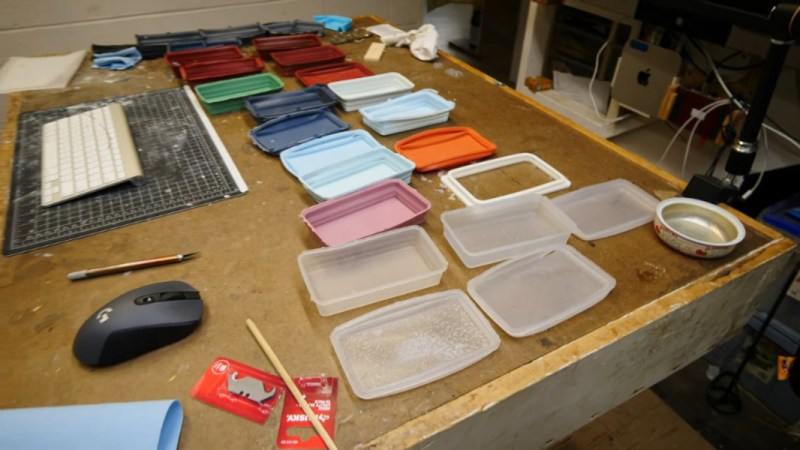How hard could it be to make a collapsible silicone container? Turns out, it’s really, really hard — collapsible containers have rigid guidelines. Just ask [Eric Strebel], who failed dozens of times before finally getting it right (video, embedded below).
 [Eric] started with an SLA-printed two-part mold and a silicone formulation with a Shore durometer of A 40 — this is the measure of hardness for silicone, polymers, and elastomers in the sense that the piece will resist indentation. The first twenty-four attempts all came out looking great, but not a single one of them would collapse and stay collapsed.
[Eric] started with an SLA-printed two-part mold and a silicone formulation with a Shore durometer of A 40 — this is the measure of hardness for silicone, polymers, and elastomers in the sense that the piece will resist indentation. The first twenty-four attempts all came out looking great, but not a single one of them would collapse and stay collapsed.
Eventually, [Eric] went back to the drawing board and played with the angles of the flex points, the thickness of the living hinges, and the wall thicknesses, which have to be strong enough to stay collapsed.
For attempt #25, [Eric] took the part out of the mold about three hours in and tried curing it in the collapsed state. Persistence paid off, and the part finally collapses and stays that way. Get yourself some popcorn and check out the fail-fest after the break. You know what we always say — fail fast, fail often.
[Eric] has made many molds both from silicone and for silicone. Some of them are really big!
















Overseas makers:
We just wanted everything done fast. To free the mold for the next one, we pulled them out as soon as they’d keep their shape, and collapsed them to save space…
I’d bet these are molded in the collapsed state and are designed to stay expanded, so they’re really expandable, not collapsible, containers.
I suspect they are not – it would be lots of very thin feature to create that zig-zag of them in the collapsed pattern – which isn’t a great idea, its just too delicate..
More likely they are just very well designed, perhaps a little differently than he does here in geometry – I’m thinking if you make the outer rings as they collapse a bit smaller than they ‘should’ be by design above it creates that elastic tension that holds them in place in both states – in effect lower or eliminate the draft angles so each outer ring is always compressing the inner more significantly as it changes state, but should like any bistable spring mechanism hold in that new position being now only slightly tensioned. Not sure if that explanation is really clear, but its not easy to describe in text alone…
Still its great to see such a accomplished and successful maker showing the many failures they endured on this path for a new method. Really should happen more often, but nobody likes documenting failures so publicly..
The “successful” version seems broken on the bottom left, and a lot too thin to be of any use.
He acknowledges that it’s broken and needs to be redone. It’s not clear if the flopping bottom is a result of the break or not.